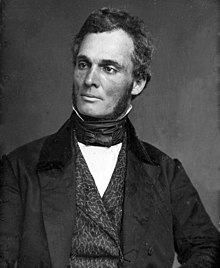

The Vigilant Association of Philadelphia was an abolitionist organization founded in August 1837 in Philadelphia to "create a fund to aid colored persons in distress". [1] The initial impetus came from Robert Purvis, [2] who had served on a previous Committee of Twelve[ clarification needed] in 1834, and his father-in-law, businessman James Forten. [3] [4]
Up and running by 1838, the committee had begun to break down in 1852. William Still was an important conductor along the railroad and a founder of the vigilance committee in Philadelphia. [5]
Its executive was the Vigilant Committee of Philadelphia and its first president was a black dentist, James McCrummell. Other abolitionists who helped included John Greenleaf Whittier, who helped form the committee and promoted the association in his newspaper Pennsylvania Freeman. [3] [4]
There were five members of the acting committee for the Vigilant Association of Philadelphia, which included Nathaniel W. Depee, William Still, Jacob C. White, Passmore Williamson, and Charles Wise. [6] [7] [8]
In June 1842, future writer Harriet Jacobs was among the fugitive slaves who were aided by the Association. [9]
- ^ Foner, Eric (2 February 2016). Gateway to freedom : the hidden history of the underground railroad. National Geographic Books. ISBN 978-0-393-35219-1. OCLC 1086231994.
- ^ Boromé, Joseph A.; White, Jacob C.; Ayres, Robert B.; McKim, J. M. (1968). "The Vigilant Committee of Philadelphia". The Pennsylvania Magazine of History and Biography. 92 (3): 320–351. ISSN 0031-4587. JSTOR 20090197.
- ^ a b Boromé 1968.
- ^ a b Tomek 2015.
- ^ Gara, Larry (1961). "William Still and the Underground Railroad". Pennsylvania History: A Journal of Mid-Atlantic Studies. 28 (1): 33–44. ISSN 0031-4528. JSTOR 27770004.
- ^ Sanders, Nancy I. (2012-06-01). Frederick Douglass for Kids: His Life and Times, with 21 Activities. Chicago Review Press. p. 54. ISBN 978-1-61374-357-7.
- ^ Switala, William J. (2008-08-21). Underground Railroad in Pennsylvania. Stackpole Books. ISBN 978-0-8117-4912-1.
- ^ Still, William (2022-02-15). "Organization of the Vigilance Committee". Toronto Metropolitan University Pressbooks.
- ^ Jean Fagan Yellin: Harriet Jacobs. A Life. New York 2004, p. 66.
- Boromé, Joseph (1968), "The Vigilant Committee of Philadelphia", Pennsylvania Magazine of History and Biography, 92 (3), Historical Society of Pennsylvania: 320–351, JSTOR 20090197
- Tomek, Beverly C. (2015), "Vigilance Committees", The Encyclopedia of Greater Philadelphia, Rutgers University
- Historical records of Philadelphia Vigilant Association Archived 2016-08-31 at the Wayback Machine held at the Historical Society of Pennsylvania


The Vigilant Association of Philadelphia was an abolitionist organization founded in August 1837 in Philadelphia to "create a fund to aid colored persons in distress". [1] The initial impetus came from Robert Purvis, [2] who had served on a previous Committee of Twelve[ clarification needed] in 1834, and his father-in-law, businessman James Forten. [3] [4]
Up and running by 1838, the committee had begun to break down in 1852. William Still was an important conductor along the railroad and a founder of the vigilance committee in Philadelphia. [5]
Its executive was the Vigilant Committee of Philadelphia and its first president was a black dentist, James McCrummell. Other abolitionists who helped included John Greenleaf Whittier, who helped form the committee and promoted the association in his newspaper Pennsylvania Freeman. [3] [4]
There were five members of the acting committee for the Vigilant Association of Philadelphia, which included Nathaniel W. Depee, William Still, Jacob C. White, Passmore Williamson, and Charles Wise. [6] [7] [8]
In June 1842, future writer Harriet Jacobs was among the fugitive slaves who were aided by the Association. [9]
- ^ Foner, Eric (2 February 2016). Gateway to freedom : the hidden history of the underground railroad. National Geographic Books. ISBN 978-0-393-35219-1. OCLC 1086231994.
- ^ Boromé, Joseph A.; White, Jacob C.; Ayres, Robert B.; McKim, J. M. (1968). "The Vigilant Committee of Philadelphia". The Pennsylvania Magazine of History and Biography. 92 (3): 320–351. ISSN 0031-4587. JSTOR 20090197.
- ^ a b Boromé 1968.
- ^ a b Tomek 2015.
- ^ Gara, Larry (1961). "William Still and the Underground Railroad". Pennsylvania History: A Journal of Mid-Atlantic Studies. 28 (1): 33–44. ISSN 0031-4528. JSTOR 27770004.
- ^ Sanders, Nancy I. (2012-06-01). Frederick Douglass for Kids: His Life and Times, with 21 Activities. Chicago Review Press. p. 54. ISBN 978-1-61374-357-7.
- ^ Switala, William J. (2008-08-21). Underground Railroad in Pennsylvania. Stackpole Books. ISBN 978-0-8117-4912-1.
- ^ Still, William (2022-02-15). "Organization of the Vigilance Committee". Toronto Metropolitan University Pressbooks.
- ^ Jean Fagan Yellin: Harriet Jacobs. A Life. New York 2004, p. 66.
- Boromé, Joseph (1968), "The Vigilant Committee of Philadelphia", Pennsylvania Magazine of History and Biography, 92 (3), Historical Society of Pennsylvania: 320–351, JSTOR 20090197
- Tomek, Beverly C. (2015), "Vigilance Committees", The Encyclopedia of Greater Philadelphia, Rutgers University
- Historical records of Philadelphia Vigilant Association Archived 2016-08-31 at the Wayback Machine held at the Historical Society of Pennsylvania